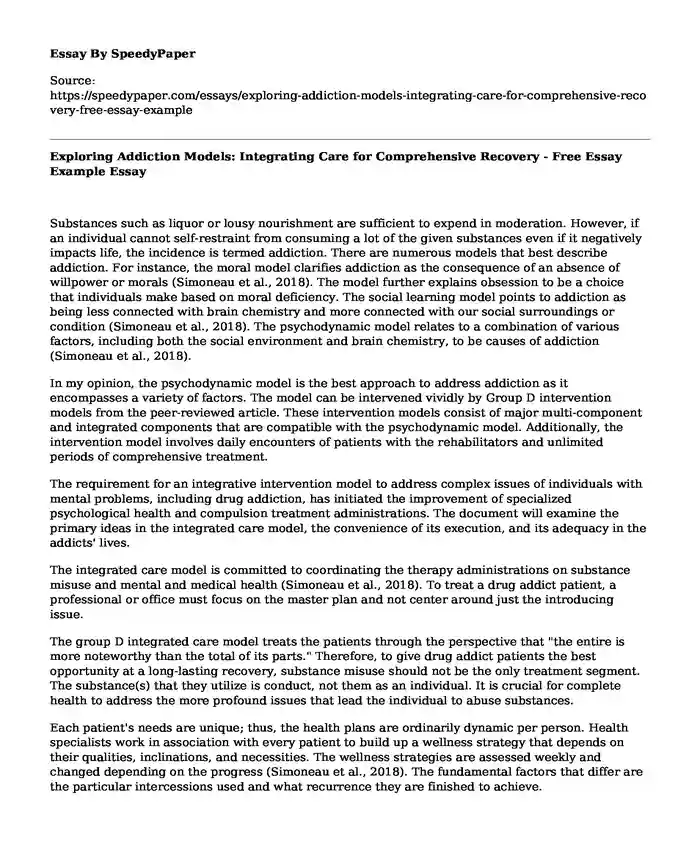
| Type of paper: | Essay |
| Categories: | Health and Social Care Psychology Drug |
| Pages: | 3 |
| Wordcount: | 658 words |
Substances such as liquor or lousy nourishment are sufficient to expend in moderation. However, if an individual cannot self-restraint from consuming a lot of the given substances even if it negatively impacts life, the incidence is termed addiction. There are numerous models that best describe addiction. For instance, the moral model clarifies addiction as the consequence of an absence of willpower or morals (Simoneau et al., 2018). The model further explains obsession to be a choice that individuals make based on moral deficiency. The social learning model points to addiction as being less connected with brain chemistry and more connected with our social surroundings or condition (Simoneau et al., 2018). The psychodynamic model relates to a combination of various factors, including both the social environment and brain chemistry, to be causes of addiction (Simoneau et al., 2018).
In my opinion, the psychodynamic model is the best approach to address addiction as it encompasses a variety of factors. The model can be intervened vividly by Group D intervention models from the peer-reviewed article. These intervention models consist of major multi-component and integrated components that are compatible with the psychodynamic model. Additionally, the intervention model involves daily encounters of patients with the rehabilitators and unlimited periods of comprehensive treatment.
The requirement for an integrative intervention model to address complex issues of individuals with mental problems, including drug addiction, has initiated the improvement of specialized psychological health and compulsion treatment administrations. The document will examine the primary ideas in the integrated care model, the convenience of its execution, and its adequacy in the addicts' lives.
The integrated care model is committed to coordinating the therapy administrations on substance misuse and mental and medical health (Simoneau et al., 2018). To treat a drug addict patient, a professional or office must focus on the master plan and not center around just the introducing issue.
The group D integrated care model treats the patients through the perspective that "the entire is more noteworthy than the total of its parts." Therefore, to give drug addict patients the best opportunity at a long-lasting recovery, substance misuse should not be the only treatment segment. The substance(s) that they utilize is conduct, not them as an individual. It is crucial for complete health to address the more profound issues that lead the individual to abuse substances.
Each patient's needs are unique; thus, the health plans are ordinarily dynamic per person. Health specialists work in association with every patient to build up a wellness strategy that depends on their qualities, inclinations, and necessities. The wellness strategies are assessed weekly and changed depending on the progress (Simoneau et al., 2018). The fundamental factors that differ are the particular intercessions used and what recurrence they are finished to achieve.
When they initially come into this form of treatment intervention, numerous patients experience difficulties in identifying their qualities. Therefore, the group D intervention model aims to transform the patients' rates for strengthening into a route for the patient’s self-support in recuperation. For instance, if a drug addict patient identifies quality as "athletic," the suggestion should be fused into their wellness strategy by alluding them to part of their physical wellness classes, alongside investigating athletic teams for their participation in terms of sober activity (Simoneau et al., 2018).
As a component of the integrated care intervention model, the patients get cognitive therapy on behaviors, solution-centered therapy, mind, spirit, and body therapies, and experiential therapies. An assortment of other integrative well-being therapies is likewise offered to the patients based on introducing needs and clinical proposals.
The integrative nature of the Group D intervention model has strategically addressed the psychodynamic, social learning, and moral models of addiction. It should, therefore, be embraced in our rehabilitation healthcare systems to counter addiction and its effects.
Reference(s)
Simoneau, H., Kamgang, E., Tremblay, J., Bertrand, K., Brochu, S., & Fleury, M. J. (2018). Efficacy of extensive intervention models for substance use disorders: A systematic review. Drug and Alcohol Review, 37, S246-S262.
Cite this page
Exploring Addiction Models: Integrating Care for Comprehensive Recovery - Free Essay Example. (2023, Dec 11). Retrieved from https://speedypaper.com/essays/exploring-addiction-models-integrating-care-for-comprehensive-recovery-free-essay-example
Request Removal
If you are the original author of this essay and no longer wish to have it published on the SpeedyPaper website, please click below to request its removal:
- End of Life Issues: The Right to Die. Essay Sample.
- Essay Example on a Health System That Keeps Us Healthy
- Free Essay on the Benefits of Raw Garlic in Preventing and Treating Disease
- Free Essay. What Deficits Do Both the Book and Talk Highlight in Regard to Women's Health?
- Employee Rights During the Covid-19 Pandemic. Essay Example
- Free Essay on Ethical and Legal Implications, Strategies to Address Disclosure
- Ensuring Quality Healthcare Services: A Complex Challenge - Essay Sample
Popular categories




